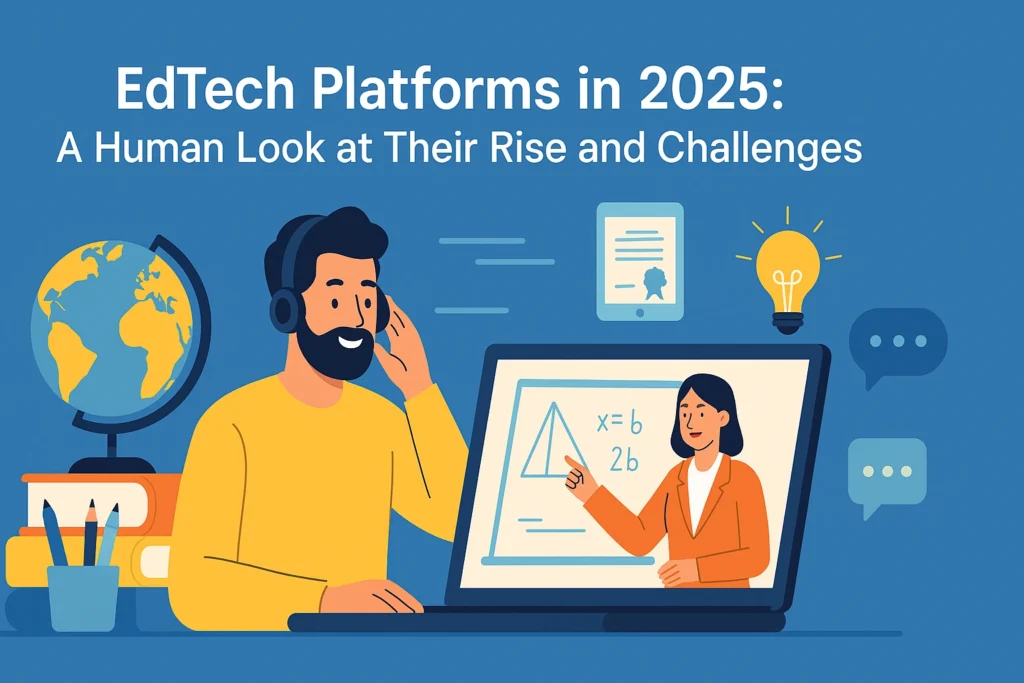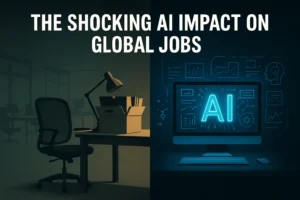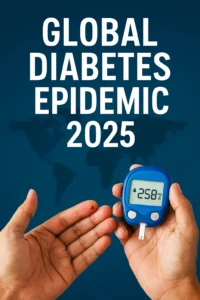EdTech Platforms in 2025: A Human Look at Their Rise and Challenges

A student engages with an EdTech platform in 2025, highlighting the blend of digital tools and human-led education
EdTech platforms in 2025 have become a vital part of how people across the world engage with learning. From school students to working professionals, millions now rely on digital platforms to study, practice skills, and earn credentials. What began as a pandemic-driven necessity has quietly evolved into a daily habit. But with all their convenience and reach, these platforms also raise important questions—about access, quality, attention, and trust.In classrooms, coaching centers, and even kitchen corners, EdTech platforms in 2025 are quietly reshaping how people absorb knowledge.
Table of Contents
1. A World Where School Lives in Your Pocket
There’s a moment I remember clearly from early 2025. I was visiting a government school outside Pune. A boy, no older than 12, was quietly working on a borrowed smartphone—typing responses into an English learning app. His class had one teacher for over 40 students. That phone? It was his only shot at personal feedback.
This, in a way, captures the story of EdTech platforms in 2025. We’re past the shiny launch phase. Today, they’re embedded in daily life—sometimes quietly, sometimes overwhelmingly.
2. Who’s Still in the Game?
EdTech looked like the future back in 2020. Then came a flood of investment, a pandemic-induced boom, and later, the crash. But a few players have found their rhythm—though not without issues.
BYJU’S: Still Standing, But Cautiously
After facing a storm of criticism in recent years—over pricing, pressure tactics, and confusing bundles—BYJU’S seems to be slowing down and cleaning house. Parents I spoke to mention clearer policies, and even phone calls from real support staff. It’s not perfect, but it feels more grounded than before.
Coursera: Global, But Distant
Coursera is still growing, especially in the professional space. Want a certificate in data analytics? You can get one, often co-branded with Google or IBM. But for all its polish, it can feel distant. Some Indian students told me the examples often assume you’re sitting in a U.S. office. Context matters, and Coursera still hasn’t cracked that.
Khan Academy: Trust Over Trend
It’s hard not to admire what Khan Academy is doing. It’s still free. Still clear. Still surprisingly helpful. In 2025, they’ve added emotional literacy tools for kids—short animations on anxiety, focus, even self-doubt. The visuals are simple, but they work. That said, their content still leans heavily on English and American syllabi.
Unacademy: A Mixed Bag
Unacademy is popular with students prepping for Indian government exams. Their live sessions can be intense, fast, and oddly comforting—like a favorite YouTuber you also learn from. But the quality swings wildly. One student called it “binge learning,” and I couldn’t un-hear that.
Duolingo: More Than Just Language
Duolingo is still fun. Now it teaches math, geography, and even a bit of science. But the gamification, while engaging, doesn’t suit every subject. A parent told me, “My daughter uses it daily but still struggles with problem-solving in school.” That tension—between habit and depth—is real.
Despite their different styles and audiences, all major EdTech platforms in 2025 are racing to find the balance between innovation and human connection.One thing is clear: EdTech platforms in 2025 are no longer just websites—they’re ecosystems.
You may also like (The Mental Health Crisis in Indian Teenagers: We Didn’t See It Coming)
3. The Trends You Might Not Notice at First
Most articles list AI, mobile learning, and modular content like it’s new. It’s not. What’s newer—and more subtle—is how students feel about learning now.
Learning Feels Fragmented
With everything broken into 2-minute lessons and animated quizzes, students sometimes forget the bigger picture. One college student I met in Delhi said, “I can complete five modules in a row but still feel like I didn’t actually ‘get it.’” That’s a red flag—and one EdTech companies are starting to notice.
Devices Rule, But Are They Helping?
A school principal I interviewed in Nagaland said this: “We’ve moved from one textbook for 20 students to 20 phones for 20 kids. But they’re distracted half the time.” EdTech didn’t remove distraction—it just changed its shape.
Teachers Aren’t Replaced—They’re Ignored
The promise was always “blended learning”—tech plus teacher. But in practice, many platforms still don’t include teachers in the loop. There’s no easy way for a 9th-grade science teacher to track what their student just learned on an app the night before.
4. Where It Gets Messy
EdTech is full of good intentions. But the reality on the ground? It’s uneven, and at times, troubling.
The Divide Is Still Here
If you live in a city, with Wi-Fi, and a decent phone, your EdTech experience might be smooth. But millions don’t. A girl I met in rural Bihar had to walk 4 km to her cousin’s house for better signal—to watch one hour of recorded class. She does it three times a week.While EdTech platforms in 2025 promise reach, the truth is that digital inequality still locks out millions of learners.
Burnout Is Quiet
We rarely talk about student exhaustion. But in 2025, it’s real. Kids stare at screens from 9 a.m. to 8 p.m., toggling between homework apps, exam prep videos, and Instagram. Sleep cycles are shot. Attention spans? Even shorter. Not everything needs to be “interactive.”
Data Concerns Are Rising
Parents are asking: what data is collected when a child uses these platforms? Where does it go? Is it used for ads? For now, there are no clear answers. Most platforms offer vague privacy policies, and there’s little accountability.Many parents remain unaware of how EdTech platforms in 2025 use AI to track performance or suggest lessons.
5. So, What’s the Way Forward?
Despite everything, I don’t think EdTech is the villain. Most founders, educators, and developers I’ve spoken with genuinely want to help. But the next phase has to be slower, more thoughtful, and more inclusive.
Here’s what might help:
Teachers need a seat at the table. They know what students miss, even when apps don’t.
Local content matters. Global platforms must stop treating Indian, Nigerian, or Indonesian learners like an afterthought.
Less can be more. Not every feature needs to be gamified. Sometimes, quiet explanation works best.
The success of EdTech platforms in 2025 will ultimately depend on how well they understand the emotional and academic needs of real students.
You can also read (World Top edtech companies )
6. Final Thoughts
EdTech platforms in 2025 aren’t just tools—they’re environments. And just like classrooms, they carry the potential to uplift or overwhelm. The hype may have settled, but the impact is still unfolding.
What matters now is simple: are students learning better—not faster, not louder, just better?
That’s the question every platform needs to ask itself. And honestly? The best ones already are. As we move forward, we’ll need to ask tougher questions about what we want EdTech platforms in 2025 to become—and who gets to shape that future.





